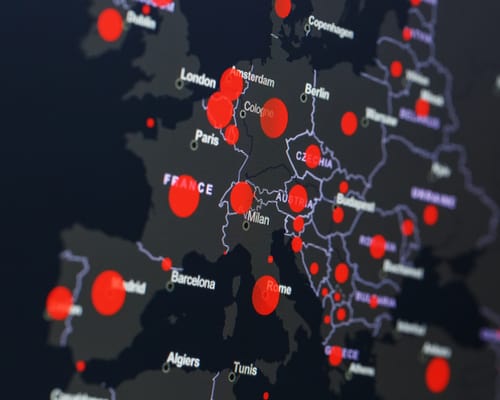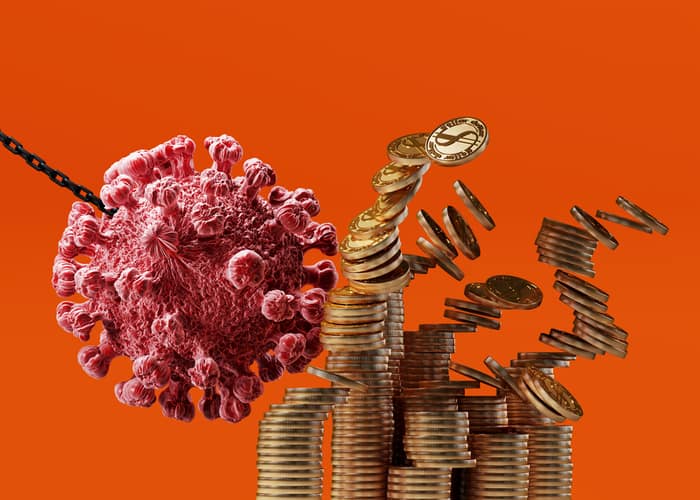Like virtually every other industry, the coronavirus pandemic caught the media by surprise. As publishers, editors, reporters and freelancers stepped off the dizzying roller-coaster ride of 2020, European Journalism Observatory editors examined the economic impact of the pandemic on journalism in their country.
Here is our analysis, which includes interviews with leading academics and experts.
Britain
It’s a no-brainer – a free newspaper that could effortlessly integrate into the buzzing after-work routine around London’s 270 tube stations. With a gift of a ready-made audience – the well-over a billion passengers passing through the UK’s capital every year – the Evening Standard model is naturally appealing to advertisers. But in 2019, the title reported a pre-tax loss of £13.6m, according to the Financial Times. And as we ended a year of covid-19 upheaval, it became one of the starkest examples of the economic turmoil that is engulfing the UK’s news media.
In August, an Evening Standard spokesperson explained that difficult market conditions, further accentuated by Covid-19, were primarily responsible for the outlet’s steep decline in circulation and the forecasted 40% cut to newsroom staff. But added that their changes also reflect the Standard’s response to the evolving behaviours and demands of their audiences.
Like every other outlet in the UK, the paper has been pursuing digital solutions. However, despite reports from audience measurement outfit Pamco of a 35% rise in digital daily readership across news brands, trade paper Press Gazette revealed deep cutbacks in the UK media and a collapse in the advertising market.
By April, the Gazette’s investigation had found that the US and UK’s largest listed news businesses had lost more than £15bn from their market capitalisations since the start of the global pandemic.
Later in August, under a headline warning of an impending cull of more than 2000 jobs across UK titles, it revealed that the press had been hardest hit as it struggles to cope with declining print readership, mobile and online trends and tech giants dominating the digital ad market.
The grim breakdown of job cuts featured leading media outlets and conglomerates such as the Guardian; DMG media, which includes titles such as the Daily Mail and Metro; and Reach, the UK’s largest newspaper publisher with Daily Mirror and the Daily Express in its portfolio. Together, they are expecting to cut at least 800 jobs. The country’s public broadcaster, BBC, has also been affected, with an anticipated 450 job losses in BBC regions and 520 in BBC News.
There have been calls for state intervention to boost the earlier pledged £35m of government advertising money and for the media to rethink its business model, perhaps focusing on reader-revenue models.
However, speaking to EJO, renowned investigative journalist and head of journalism at City University, London, Paul Lashmar warns against lumping together all parts of the media sector: “We like to generalise but there are lots of different media organisations conducting themselves in quite different ways, in any given moment. Lots of people are trying to revise business models, and they have been trying for 20 years to find a model that works – with varying degrees of success.
“COVID is a real blindside. It’s taken everybody by surprise and has had a serious impact on practices and budgets. But the fact remains that people need quality news and high-quality journalism more than ever. I think that the ‘Trump factor’ is still in play, that there is an appetite for reliable, accurate, fact-checked information and people are willing to pay for quality content. Whether this will save the print industry is not yet clear, but I hope so.”
These complexities and contradictions in the analysis of the UK’s media economic state are evident in the Press Gazette’s November list of news companies which are now more valuable than they were before the coronavirus crisis began. It includes ITV, which added 37% to its market value, Daily Mail and General Trust, which added 3%, and Reach, which grew by a whopping 63%.
Some media actors have pointed out, that, though economic effects are inevitable, it will be a while before we can truly measure the impact of Covid-19 on the news sector.
As a vaccine is rolled out and the UK exits the European Union, we will have to wait to see how the emerging picture takes shape.
Georgia
The outbreak of the coronavirus pandemic has plunged Georgia into a deep economic crisis. Georgian companies have reduced their advertising, which has had a big knock-on impact on the media.
For example, before the outbreak of the pandemic, television advertising revenues were growing, but then fell by four percent in March, according to a report by the independent Georgian National Communications Commission (GNCC). Nevertheless, overall advertising revenues rose by seven percent in the first quarter.
However, by the second quarter of 2020 television advertising revenues had fallen by almost 40 percent. In the third quarter of 2020 they increased by 24 percent compared to the same period last year. According to Transparency International Georgia’s media program manager, Mamuka Andguladze, revenues from political advertising for the parliamentary elections on 31 October were able to compensate, to some extent, for the losses due to the coronavirus crisis.
Looking forward, enormous losses are also expected to hit other media sectors, such as the press. These were not very noticeable in 2020, as most of the advertising clients have annual contracts, the majority of which have been adhered to, explained business journalist Maia Demetrashvili.
In terms of government support, there is no anticipated financial aid for the independent media. Of course, election advertisements only served political purposes, says head of a media agency Theimuraz Tchumburidze. The government has mobilised about one billion euros to save the Georgian economy. However, Tchumburidze points out that independent media have not been supported, neither with financial aids nor in the form of tax reductions.
It is worth noting that the Georgian government is very critical of independent media. In spring, a law was drafted to stop “fake news” and restrict news dissemination about the corona pandemic to government sources. However, the bill was criticised as an encroachment on press freedom and was softened.
Mariam Gogosashvili, executive director of the Georgian Charter of Journalistic Ethics, which is committed to the implementation and protection of journalistic norms and professional standards in the media, also criticised the lack of state financial support for the media.
Furthermore, Tchumburidze highlights the need for more support for media from the European Union. He points out that, “due to its bureaucracy and lack of transparency, the EU is not perceived here as a supporter of the media”.
Tchumburidze, Gogosashvili and Demetrashvili say that it is the US embassy, American foundations, and other NGOs that have been assisting journalists. Some of them, for example, have developed guidelines for dealing with and reporting on Covid-19 for the Georgian media and have conducted campaigns to raise awareness among journalists and the public.
Demetrashvili adds that, during the pandemic, pre-existing beneficial services such as English courses for journalists were continued digitally.
Germany
With huge slumps in advertising income, short time work and significantly fewer jobs for freelance journalists, the economic crisis triggered by the coronavirus pandemic is hitting the German media industry hard.
According to the Federal Association of Digital Publishers and Newspaper Publishers (BDZV), in April 2020 almost all publishers recorded a drop in advertising revenue of more than 20 percent and in some cases as high as 40 percent. Increase in short-term work affected editorial offices across the country, including national titles such as Die Zeit and Süddeutsche Zeitung. Both decreased their amount of pages in the spring as the Covid-19 crisis reduced the events that departments such as sports and culture can cover.
In fact, the events segment is currently almost non-existent. Tina Groll, chairwoman of the German Union of Journalists, and editor at Zeit Online, describes this as “fatal”, since in the last few years the organisation and moderation of events became a second or third mainstay for many outlets.
Media companies which were “not innovative enough to develop viable business models” are now paying the price, says Groll. On one hand, people’s need for quality journalism has “increased enormously”. On the other hand, short-time work is becoming more common in many newsrooms. A fact, which Groll branded “absurd”.
“There is only one solution, media houses need to become more independent of advertising,” says Christopher Buschow, Junior Professor for Organisation and Networked Media at the Bauhaus University Weimar. He adds that local newspapers, in particular, should see themselves more as “companions and supporters of the people in the local area”. Accordingly, they should “address more users with tailored offers and then turn them into paying users”.
Although Buschow believes that local media have managed to become “an important anchor point and service provider” during the coronavirus crisis, he stressed that this understanding must be “anchored even more deeply” within media companies and should inspire a greater awareness of their customers’ needs.
Another important aspect of the economic impact of the pandemic is the particularly adverse effect on freelance journalists, who have had many of their commissions cancelled. “From an economic point of view, it is devastating that many freelance journalists do not benefit from the corona emergency aid programmes. Improvements are currently being made – but these come much too late,” says Groll.
There are government grants for self-employed individuals, but so far these have only been paid for ongoing business expenses and not for loss of income. Baden-Wuerttemberg is the only federal state offering self-employed individuals financial support for their private lives. However, the issue is being discussed in the federal state of Bavaria.
Both Groll and Buschow view the coronavirus crisis also as an opportunity for media outlets. “In some media houses digitalisation is now advancing very fast,” Groll points out. Many newsrooms have successfully tried out podcasts and live blogs, and some publishers are now positioning their contents “more self-confidently” online.
According to Buschow, the important question is how to support existing actors who still play a role, but at the same time initiate innovations? He adds that financial support for start-ups and appropriate framework conditions would definitely be needed in order to create new ideas, concepts and formats in the German media industry.
The public sector could also play a role, says Buschow. However, the media scientist is sceptical about the German government’s plan to support newspaper and magazine publishers with 220 million euros in the coming years to manage their “digital transition”. At the end of October, it was announced that the amount of subsidies should be linked to the number of copies – so more money for higher circulations. For Buschow, this would be a “wasted opportunity” as it rewards publishers who are already doing well.
Italy
The pandemic hit the Italian media market hard, especially in regards to advertisement income. Data provided by Osservatorio Stampa FCP revealed an overall 26.6 percent decrease in print advertising in 2020, as well as a 19.8 percent drop for dailies, and a 40.3 percent for magazines. However, digital platforms registered less severe losses and, according to IAB Italia research, will close the year with only a four to eight percent reduction in income.
But the pandemic impacted on an already weak market, haunted by long-lasting systemic problems and sharp decreases in circulation, especially for the dailies which, in the past six years, witnessed an “extraordinary decline”. The pandemic also caused many newsstands to go out of business. According to estimates released by the Italian union of newsagents Sindacato nazionale autonomo giornalai (Snag), 1,410 newsstands closed down in the first half of 2020.
To help the sector during the Covid-19 pandemic, the Italian government has approved a series of support measures, including tax credits on advertisement investments and help with the cost of paper. In November 2020, it also created a dedicated 50 millions euros fund to support local radio and tv broadcasters. Furthermore, a 500 euros bonus was introduced for newsstands.
However, inevitably, the difficult economical indicators resulting from the pandemic jeopardized work safety and employment conditions for journalists. According to Raffaele Lorusso, General Secretary of Federazione Nazionale Stampa Italiana (FNSI), the largest Italian journalists union, “numerous Italian publishing companies used the Covid-19 ‘cassa integrazione’, a “short-term work” furlough scheme, funded by the government until the end of 2020. As of December 2020, there are 990 furloughed journalists out of a working force of 15’000.” The government has extended a block on layoffs until March 2021.
When it comes to journalism freelancers, they were given access to the same bonuses created for all Italian self-employed workers. “Freelance journalists were granted a 600 euros one-off bonus in March and April”, says Debora Malaponti, an activist for ACTA Media,which represents freelancers. “The May one-off 1000 euros bonus, that followed, was introduced with some specific criteria that left some freelancers behind,” adds Malaponti.
However, it is clear that both freelancers and stafff in media companies in Italy are facing extremely precarious working conditions and low wages. In fact, a survey coordinated by ACTA and Slow News revealed that 68 percent of Italian freelancers make less than 10,000 euros annually.
While the emergency measures put in place by the government were welcomed, they’re clearly only a limited response to the structural challenges and constraints of the Italian journalistic market.
“These governmental measures have been a breath of fresh air both for companies and workers”, says Lorusso commenting on the Italian response to the pandemic. Yet, in his view, it is clear that more needs to be done.
He adds: “The crisis of the industry began before Covid-19 and the sector is now in full transformation. We need public support to enable companies to pursue digital innovations, encourage the public to read and modernize the sales network.
“Moreover, structural intervention is needed to fight precariat and support stable employment. A step change is required from the government in order to combat the many inequalities in the job market that are now jeopardizing the future of generations of journalists and quality of information.”
This appears to be even more urgent when it comes to freelancers, who are more directly and severely affected by existing systemic problems worsened by the pandemic.
“Given the extreme conditions freelancers are subjected to from well before the pandemic, we believe that structural interventions are needed, instead of emergency measures”, says Malaponti. She adds: “This includes fair pay for jobs and contributions that consider risks involved in being self-employed. We, as ActaMedia, urge colleagues to refuse poorly paid jobs and to be wary of commissioners who unilaterally impose cuts to payments because of Covid-19.”
Latvia
At the beginning of 2020, Latvian media firms faced serious losses. Throughout the year they were forced to balance state support measures and the sharp decline in advertising revenue.
The Latvian Association of Journalists branded the closure of the oldest news service and second largest commercial television channel LNT as the worst media event in the last decade. Some of LNT’s staff were able to switch to TV3, but many lost their jobs. Furthermore, one of the three daily newspapers, the Neatkarīgā Rīta Avīze (Independent Morning Newspaper), announced that it was moving all its content to digital platforms. Several local and regional outlets were also forced to reduce the frequency of their publication.
When advertising partners started to withdraw their orders in early 2020, some media companies reacted with cuts to aspects of journalists’ jobs, a refusal to engage freelance journalists and the reduction of staff salaries by 20 to 30 percent.
Currently the media and the Latvian government have only been able to respond reactively to the actual problems, according to Arta Ģiga, Chair of the Board of the Latvian Journalists’ Association.
“The economic existence of the media is seriously threatened during the crisis, and this is clear to everyone. But there are no serious, sustainable decisions that can prevent this process. Equally important is the decline in media quality and editorial independence that comes as a result of growing barriers in access to information for media professionals. The media agenda is set by the government and the media do not oppose it. This is a very dangerous trend,” says Ģiga.
At the onset of the Covid-19 crisis the Latvian Media Support Fund provided assistance for content creation, coverage of broadcasting expenses and postal delivery costs. Under the governmental ‘Support for the media to mitigate the negative effects of the Covid-19 crisis’ program, the Media Support Foundation distributed more than a million euro.
Euro 522,415 was allocated to national print and online news media; €223,737 was used for the monthly delivery costs of subscribed press publications; €217,699 for the monthly broadcasting costs of electronic media programs during an emergency; and €220,000 was given to support regional print media and internet news portals, as well as the Latvia’s diaspora media. Additionally, the National Electronic Mass Media Council managed €700,000 euro allocated for public and commercial electronic media.
This support was very important for local and regional media, whose already declining advertising investment was severely impacted by the pandemic.
According to the information provided by the Chairman of the Board of the Latvian Advertising Association, Baiba Liepiņa, for the first six months of 2020, the total advertising market volume was 30.395 million Euros. Compared to the same period last year, the decline in the market exceeds 10 million Euros, which is almost a 25 percent drop. In the first half of 2020, market share increased by more than two percent for online advertising and by one percent for television advertising.
Advertising revenues of TV and radio companies will decrease by 20 – 30 percent this year, which means that the losses will be from eight to 12 million euros, forecasted Andris Ķēniņš, head of the Latvian Broadcasting Association.
Currently, Latvian media professionals’ associations are lobbying the government to, at least, maintain funding levels from the Media Support Fund in next year’s budget.
Poland
Undoubtedly, hardly any media company in Poland remained unscathed by the COVID-19 pandemic. Lockdown measures imposed by the government in spring 2020 halted many areas of economic activity, leading to lower levels of marketing and advertising spending, says Tadeusz Kowalski, professor of media economics from University of Warsaw.
Consequently, most of the media outlets saw a shortage of advertising revenue. For the first time in history, even online advertisements experienced decline, with a 4.5 percent drop in the first 6 months of 2020. Publishers of regional dailies claim that revenues plummeted by 80 percent in the second quarter of 2020. By September 2020, the advertising market had fallen by 12 percent.
Media entities, such as the conservative media group Fratria, resorted to seeking support from their users through donations and online subscriptions.
Andrzej Krajewski, an experienced journalist and a member of trade union Towarzystwo Dziennikarskie, points to examples such as Agora, the owner of the broadsheet ‘Gazeta Wyborcza’, and ZPR Media, the publisher of the tabloid ‘Super Express’, where there was a 20 percent, six-month wage cut for all the staff. Gazeta Wyborcza also laid off about 10 percent of its staff. Online, staff at the subscription-funded HaloRadio were affected by even deeper cuts, with 25 percent knocked off the hourly fee for editors. Interestingly, employees-owned opinion weekly ‘Polityka’ did not resort to wage cuts.
In public media, national television (TV Poland) and radio (Polish Radio) were heavily subsidized with €500m from government’s 2020 budget. There were no wage cut-offs or pink slips, but the advertising income for the Polish Radio fell by 20 percent, and for their second most popular programme, PR3, by 25 percent.
Some foreign companies on the Polish market also reduced the number of employees and wages. For example, Burda Media Poland dismissed one fifth of their employees (50 people), while Edipresse in April laid off 31 people and reduced wages by 20 percent for 6 to 8 months.
According to Krajewski some media companies took advantage of the epidemic, using it to launch and justify unnecessary wage cuts and even lay-offs; and to apply for government concessions.
Looking at the large-scale impact on media companies, while we haven’t found examples of outlets which have had to close purely as a result of the pandemic, many of them limited the scope and scale of their activities. What has already happened was closure of several printed magazines, specialising in travel and hobbies. Additionally, one of the opinion weekly, ‘Wprost’, stopped issuing its print edition and went online only. However, this title was already weak before the outbreak and, according to media observers, the pandemic just accelerated the decision to go digital.
The fact is that most of the newspapers encountered a dramatic decrease in sales. For example, local weeklies saw a 40 percent drop in sales in March. Local media publishers, interviewed by the specialist magazine Press, predict that Poland may become a ‘local media desert’.
In terms of public aid, Kowalski notes that though there was no specific public subsidy policy focused on media companies as such, firms were able to benefit from general public policies designed to fight the negative effects of Covid-19. For example, media companies and freelancers could apply for public aid through mechanisms such as social security fees exemptions and loans.
Local media outlets were also able to benefit from additional institutional advertising from the government and governmental institutions. On the list of the beneficiaries of the first edition of the anti-covid governmental shield are a dozen or so medium and big publishers. They had to fulfil some criteria, the most important of which was a promise to maintain their numbers of employees until the end of the year. They could also apply for loans with partial repayment terms.
Gremi Media, which publishes the second biggest broadsheet ‘Rzeczpospolita’, received the largest pay out of 3,5 mil zł. Polityka received 1,5 mil zł and Wprost, 1,38 mil zł. On the other hand, RASP, which publishes ‘Fakt’, ‘Newsweek’ and ‘Onet’; and regional dallies Edipresse, Bonnier and Polska Press did not receive government support.
Portugal
The coronavirus pandemic has created what may well be considered the perfect storm for the Portuguese media landscape. After years of revenue loss due to the rising influence of search and social platforms, industry analysts predict that the pandemic might trigger ad revenue losses of 40% to 50% in 2020. As Sofia Branco, the President of the Portuguese Journalists Union put it: “In addition to bringing new problems, the pandemic highlighted some of the problems that already existed.”
Since March, OberCom Observatório da Comunicação has been tracking the financial impact of the pandemic on the Portuguese media ecosystem. The main conclusion is that, except for radio, media, in general, suffered a spike in audiences between March and April, due to what can be characterized as “information-thirst”, during lockdown.
March and April were very difficult for radio. The average 20 minutes a Portuguese spends in a private vehicle are very important to guarantee a steady flow of ad revenue for this medium. Of course, lockdown meant no commuting by either public or private transportation, the latter being radio’s most profitable listening context.
But if we take a look at TV, we can clearly see the mentioned spike in March and April. However, viewership then stabilised to regular levels due to the normalisation of the pandemic, and to what some experts refer to as ‘info-saturation’. In March and April this quest for information may have been a desirable scenario for advertisers. However, as this declined in the following period, so did ad investment.
In the first semester of 2020, the press’ paid circulation fell by 19 percent compared to the same period in 2019. Even though digital paid circulation rose by 50.2 percent, the relative financial value of each digital unit is much lower than the printed one, with the Portuguese market being excessively traditional and outlets still relying on both sales and print ad revenue.
As has been highlighted year after year in the Reuters Digital News Report on the Portuguese media, one of the biggest vulnerabilities of the country’s press sector is the lack of consolidated digital business models. Brands are still trying to figure out how to monetise digital news when only 10% of the population paid for digital information in the previous year.
Only Público, which has a daily print and digital subscription, and Expresso – daily digital and weekly print, subscription and buy-print-get-digital formats, have managed to demonstrate notable growth. Público grew an astonishing 101.9% in the first quarter of 2020 compared to first quarter of 2019, while Expresso grew by 48.6%.
So, the pandemic, specifically the State of the Emergency declaration and subsequent lockdown, had a very significant impact on journalism. A recent nationwide study revealed a grim picture, as 799 journalists, a significant percentage of the country’s media staff, were either laid off or forced to take a salary cut. The study points out that there is an equally significant rise in precariousness, not only for young journalists but also for older professionals with more experience and much more stable contracts.
This rise in uncertainty hasn’t even spared professionals in leadership roles. The authors mention that, of the 11.8 percent of journalists whose job security was directly affected, 17 percent lost their jobs, and 11.1 percent were placed on a layoff scheme. Many professionals lost their freelance and collaborative jobs.
Sofia Branco, president of the Journalists’ Union, points out the particular precarious situation facing freelancers. She says: “In March, most of the freelance journalists stopped working, they were among the first to lose their jobs because they had no ties to the media companies they worked for.”
In April / May 2020, the Portuguese government established a financial support fund for news media totalling €15 million, €11.25 million of which was allocated to outlets with national reach and €3.75 million to local press. This fund is not a subsidy but rather an anticipated purchase of institutional advertising space to compensate for the loss of ad revenue during March and April 2020.
There was some controversy surrounding, not only the measure itself, but also the way the money distribution was calculated. According to Branco, “the institutional advertising advance measure was a good measure, but it was poorly communicated and poorly implemented”. She emphasises that not having specific allocations for the media sector in the state budget is worrying.
With the government’s lack of focus on the media ecosystem, there were some entities like Fundação Calouste Gulbenkian, which launched several financing lines to produce journalistic and information products about the pandemic.
Spain
Our examination of the impact of the pandemic in Spain on media reveals deep declines in advertising revenues from March to August 2020: 32 percent in the case of newspapers, radio – 26.2 percent, television – 25.3 percent and internet – 7.8 percent, according to the TREND SCORE report. This year the average fall in investment in communication is expected to be around 21 percent.
Furthermore, hundreds of professionals in major media groups have been affected by temporary layoffs under the Temporary Employment Regulations – referred to in Spain as Expediente de Regulación Temporal de Empleo (ERTE). Measures include suspending work for a specific time and reducing work hours.
Twelve hundred employees from Mediapro were affected. The group, which has important rights in football competitions and manages several audio-visual companies, including Overon, and production companies, such as Globomedia, has the highest rate of staff on ERTE.
“It is a great paradox that media are experiencing an increase in their audiences and at the same time, they face an advertising crisis, which puts at risk this public service, but also thousands of jobs,” says David Álvarez, media expert and professor at the Complutense University of Madrid.
Álvarez points out that that the Vocento Group, for example, is proposing a 40 percent reduction in corporate staff’s working hours. The Joly Group is also planning ERTE reductions in its nine headlines: Diario de Cádiz, Diario de Sevilla, Diario de Almería, Diario de Jerez, Málaga Today, Granada Today, Diario of Córdoba, Huelva Information and Southern Europe. According to Álvarez, this “is only a preview of the crisis that is looming in the sector and that is linked to other crises affecting the media in recent years”.
Recently Infolibre published an article, which claimed that the media lost almost two billion euros of their value on the stock market due to the pandemic. The market capitalization of Prisa Group fell by 71.6 percent, while Mediaset’s was halved. Furthermore, Atresmedia’s share has depreciated by 22 percent since March and Vocento’s by 40 percent.
“There has been no government leadership in providing direct aid to the press, which is essential to fight against misinformation and hoaxes, especially in times of pandemic”, says Victoria Pérez, president of the Platform for the Defence of Freedom of Information. She adds that newspapers such as Público were fighting for VAT reduction on subscriptions, noting “this measure was not enough”.
Álvarez points out: “We did not receive financial aid, rather shareholders assumed the economic losses to avoid problems. The EU is mandated to protect societies, citizens and freedoms against hybrid threats, in particular against disinformation and false information” as outlined in their Strategic Agenda for 2019-2024. But Pérez stresses that media have not received any help from the European Union and there has been no structured plan.
Last year, El Diario announced that its local edition in Castilla y La Mancha would receive assistance from the European Journalism Centre. This is a small amount, 25,000 euros, but it will help the newspaper to continue with the regional coverage of the pandemic. Furthermore, the European Journalism COVID-19 Support Fund distributes aid in support of local and community journalism across Europe, an initiative of vital importance for the sector.
Ukraine
The COVID-19 pandemic has considerably influenced the economic situation of the Ukrainian media. This is particularly true for the outlets, which, unlike those owned by oligarchs, have been trying to achieve independence and find their own working and sustainable business model.
Specifically, the pandemic has exposed the Ukrainian media landscape to considerable shortages of advertising revenues, job losses and even the closure of a number of news outlets – with local media being hardest hit. The government hasn’t responded with funding assistance, so Ukrainian news organisations have been seeking the support of international donors and trying to establish new ways for gaining income, for example through audience financing.
At the beginning of the coronavirus crisis in spring 2020, a number of Ukrainian media stopped or paused some of their projects, shortened their cooperation with freelancers or cut the salaries of journalists. Amongst others, the Redaktsia media project was shut down in Odesa Oblast, and the online Hromadske TV Cherkasy put its website “on pause“.
While the nationwide online media claimed a drop in advertising revenue of up to 50 percent, the local media suffered a decrease of up to 70-90 percent. Local outlets no doubt are bearing the brunt of Covid-19 impacts with limited options for funding outside of advertising.
According to Andrii Ianitskyi, Head of the Centre for Excellence in Economic Journalism at Kyiv School of Economics, the crisis forced the Ukrainian media to find new income streams. Before the pandemic, outlets mostly counted on advertising revenues and money from investors or oligarchs, with some rather exceptional cases where they depended on grants from international donors.
“Amidst crisis, the independent media shifted to getting money from the readers. Some of them launched a paywall, some asked for donations, some set up the membership models,” Ianitskyi explains.
As international donors tried to reassign their funding due to the coronavirus crisis and to support the media as a whole, those news organisations that used to depend exclusively on donors before COVID-19 crisis were forced to look for new sources of income, such as crowdfunding.
The outlets relying on oligarchs and investors were also affected by changes and reductions, as the owners tried to lessen their expenditures.
However, as Ianitskyi points out, currently the situation is turning around. “As I see it, the grants have come back. Little by little, the advertisers are getting back. But it is clear that the old model that used none but advertisement and owners’ money, despite having worked up to 2019, won’t work anymore. Now media outlets are looking for new, more diversified, business models,” he says.
Project coordinator:
Tina Bettels-Schwabbauer, Erich Brost Institute for International Journalism, TU Dortmund, EJO Germany
Contributors:
Johanna Mack and Roman Winkelhahn, Erich Brost Institute for International Journalism, TU Dortmund, EJO Germany
Leli Bibilashvili, Natia Kaladze and Salome Tsartsidze, The University of Georgia (Tbilisi), Georgia
Halyna Budivska, Kyiv Mohyla School of Journalism, EJO Ukraine
Álex Costa Escuredo and Dimitrina J. Semova, Complutense University of Madrid, EJO Spain
Philip Di Salvo, Università della Svizzera italiana, Lugano, EJO Italy
Natricia Duncan, City, University of London, EJO England
Michal Kuś and Adam Szynol, University of Wrocław, EJO Poland
Ana Pinto-Martinho and Miguel Paisana, University Institute of Lisbon, EJO Portugal
Anda Rožukalne, Riga Stradiņš University, Latvia
A version of this article was first published on the EJO Germany website.
Opinions expressed on this website are those of the authors alone and do not necessarily reflect or represent the views, policies or positions of the EJO or the organisations with which they are affiliated.
Tags: British Media, Covid-19, covid-19 media impact, Georgia, German Media, Italian Media, Latvian Media, Media economics, media post-coronavirus, Polish Media, Portuguese journalism, Spanish Media, Ukrainian Media















































